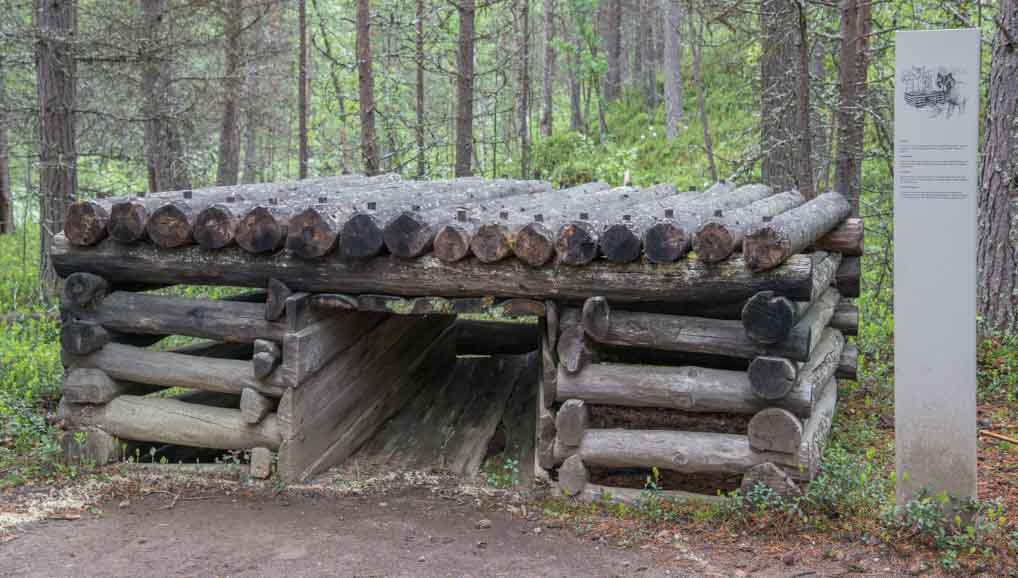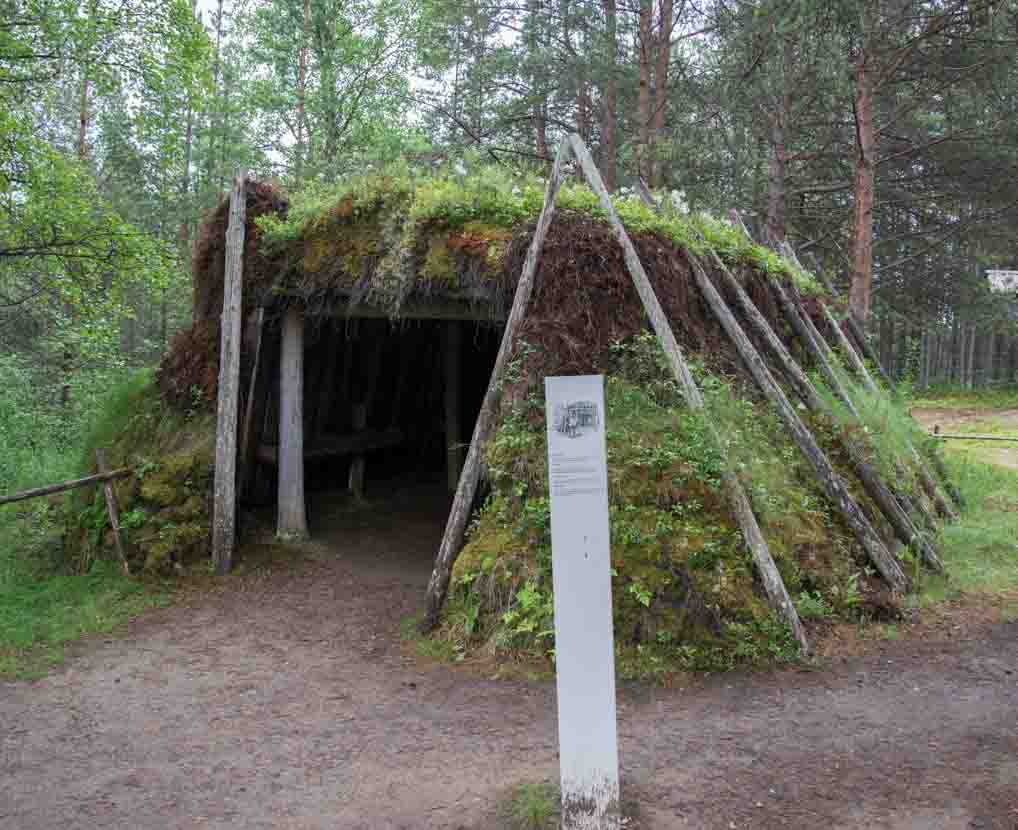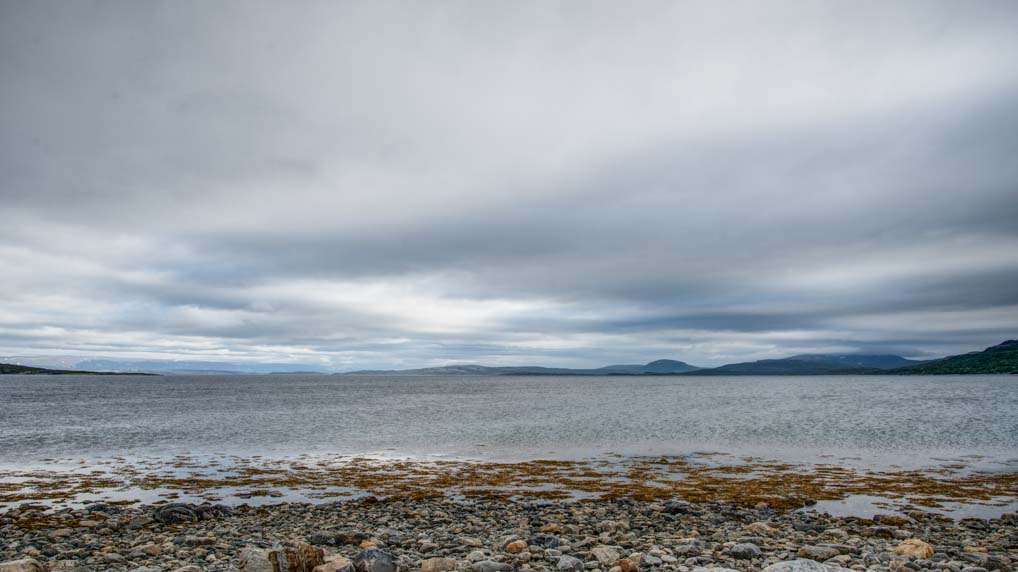What a difference a day makes. We started in Finland, which has been lovely but frankly we were getting a bit fed up of lakes and forests, and ended in Norway on the banks of a fjord.
We commenced the day with a short drizzly drive to Inari, the capital of Sami Finland. Basil squeezed himself in amongst 19 other motorhomes in the car park at Siida, the museum of Sami culture. The Sami are the indigenous people of northern Finland, Noway, Sweden and part of Russia. Historically they farmed reindeer by following them during the summer on their migrations to the sea and supplemented their reindeer herding with fishing and hunting. In the winter months they lived in small villages. They have been much persecuted and all the countries involved have, to a greater on lesser extent, tried to eliminate their culture.
Siida is an attempt to both explain Sami culture and also detail life and nature as the seasons change in this inhospitable climate. The indoor portion of the museum has one section of wildlife and a second on the Sami. It is one of those museums where there are not that many exhibits, it is mostly written explanations with photographs and drawings and although it was interesting I felt that I probably have got as much out of a good book on the same subject.

Sami Village House

Sami Sledge
Outside various Sami buildings and structures have been erected in a forest park. The houses were essentially log cabins from 50 or so years and ago and I wondered how much these actually differed from the houses of non Sami Finns. More interesting were their animal shelters and structures they used when on the move in the summer. All romantic notions of the Sami as indigenous people living at one with nature were scuppered by a gruesome set of ingenious traps for killing wolves, wolverines, bears and even martens, in fact anything that threatened their reindeer.

Wolf Trap

Reindeer enclosure – to protect them from the elements and the mosquitos!!

Sami summer shelters
I would say it is worth visiting if you are in the area, but cannot agree with Lonely Planet’s “must see” tag other than it is one of the few things to see in the area, other than the landscape.
We carried on towards Norway and as soon as we turned off the Arctic Highway towards Nordkapp the traffic thinned out. Much of the first section of this road is being upgraded with long sections of temporary rough gravel. On one of these segments, in a queue of slow moving vehicles, I looked in my rear view mirror to see a coach overtaking all of us, in the roadworks, at twice everyone else’s speed. As the coach steamed past us Sarah and I broke into laughter when we saw the coach’s number plate. Italian!!! You can take an Italian out of Italy but can’t take Italy out of an Italian.
The final section of Finland was barren indeed. Pines gave way to stunted silver birch. Forest changed to scrub, bog, lake and moorland. When we finally crossed the Norwegian border, within a few miles the change in scenery was dramatic. Mountains, valleys, waterfalls and fast flowing rivers. In fact everything you might expect from Norway, but it’s amazing how quickly things change from crossing the border.
The Norwegian cost of living also made itself apparent quickly. I topped up with diesel at €1.66 a litre and a 500 ml bottle of coke, which I did not buy, was over €3!
We drove about 60 miles in Norway until we reached Porsangerfjorden our first Fjord. It is not very dramatic by Fjord standards but even with low cloud it has a stark beauty. It reminds us, not surprisingly, of northern Scotland. It is also our first sea with a significant tide since we crossed the channel and it was nice to see acres of sea weed at low tide.
As we looked for somewhere to park up for the night (Norway has the same “everyman’s right” as Finland meaning we can camp anywhere) we had some incredible luck with wildlife. First, perched on the side of shoreline on a rock, a large eagle. It was a main road so we couldn’t stop, but it could only be a Golden Eagle or a Sea Eagle. Then while we were looking at a potential stopping place Sarah spotted an Arctic Fox. It seemed oblivious to Basil and trotted about within 50 metres of us for two minutes or so. Of course as soon as I put my birding lens on my camera it disappeared!
We have finally pitched up on some rough ground about 20 metres from the Fjord. It is about 10 degrees celsius, overcast and windy. My shorts are again looking inappropriate!

Porsangerfjorden
Northern Norway is the most multinational of the places we have so far visited on this trip. Today we have seen motorhomes and cars from 14 different countries. What an intrepid lot us Europeans are, making our way so far north, by road, in our droves. No other Brits today though.

Porsangerfjorden
Our plan was to go to Nordkapp tomorrow because the forecast is for clear skies and so it would mean seeing the midnight sun from Europe’s most northerly point. Basil is threatening these plans because in the last few miles he has been flashing the faulty airbag light at me. Because Basil was bought in Germany my Fiat manual in in German, but Google translate has helpfully told me I should contact Fiat ASAP. So first thing tomorrow I shall be calling FIAT Assist, FIAT’s camper breakdown service under which Basil is still covered, to find out what to do. Let’s hope they say ignore it until you reach a FIAT service centre, but I somehow doubt it. If we need repairs doing in Norway Sarah and I might have to go back into employment to pay the bill!!
Finally our brief thoughts on Finland. It surprised us in a good way. In good weather the lakes and forests are like nowhere else we have visited and are spectacularly beautiful. It is however possible to have too much of a good thing and by the end of our time I would say we were beginning to get a little tired of forests. The scenery is too unchanging to keep our interest for longer than a couple of weeks. That said we did not visit the Baltic coast which would have given a different experience. Undoubtedly the highlight was seeing the wild bears and it is exciting to still have somewhere in modern Europe where you can walk in forests that are still inhabited by bears, wolves, wolverines, elk and so many other animals that were long since made extinct in Britain and so many other countries.
*Apparently means “Hello Noway” in Norwegian.
